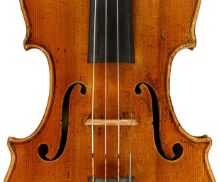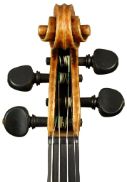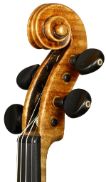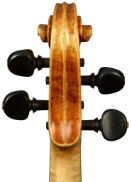Violin, Giovanni Battista Guadagnini, Milan, 1751−1753
Printed label: “Joannes Baptista Guadagnini Pla- / centinus fecit Mediolani 17..” [cross as well as the initials GBG P] (the last two numerals of the year are illegible)Although the two final numerals on the printed label (which are to be filled in by hand) are illegible, the violin is likely to have been built in the early 1750s. Guadagnini had fully developed his own style by that time, which is plainly visible in this violin thanks to its good state of preservation. The contours are identical with those of the instrument from 1749. Only the cut of the f-holes is slightly different. This model has medium-high arching and is extraordinarily well-proportioned. The two halves of the belly are not from the same log but have a very similar structure. The annual rings are fine in the middle and grow broader toward the flanks. The youngest tree ring of the belly was dated to 1731. The divided back has weak and very broad flames. By contrast, the maple ribs are more tightly flamed. The purfling has a wide middle strip and is executed very regularly. The violin has very upright f-holes with longish, oval lower eyes typical of Guadagnini’s style. The pegbox and scroll are lightly flamed and bear the hallmarks of the master’s deft craftsmanship. Unlike in many of Stradivari’s instruments, the volutes are not finished perfectly smoothly but rather show toolmarks in several areas. An attractive reddish color varnish is still clearly visible over the golden-yellow ground. The varnish is lighter than that of the violin from 1749. The instrument has outstanding tone and is in a very good state of preservation.












